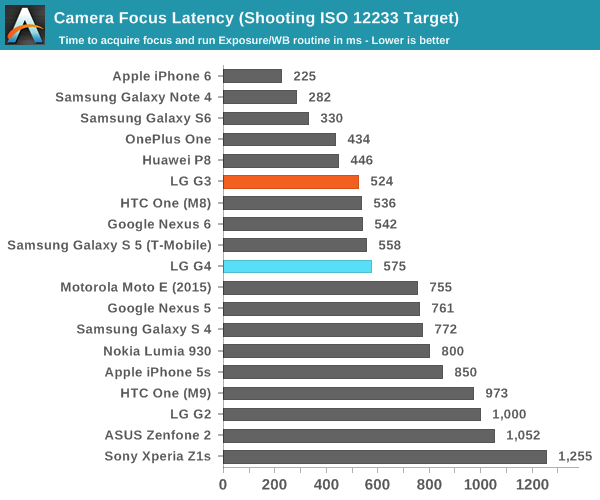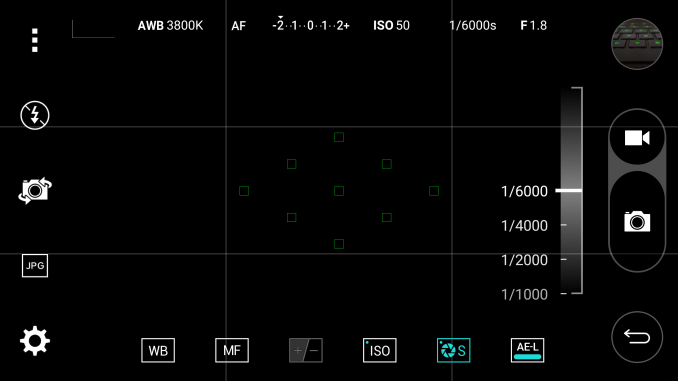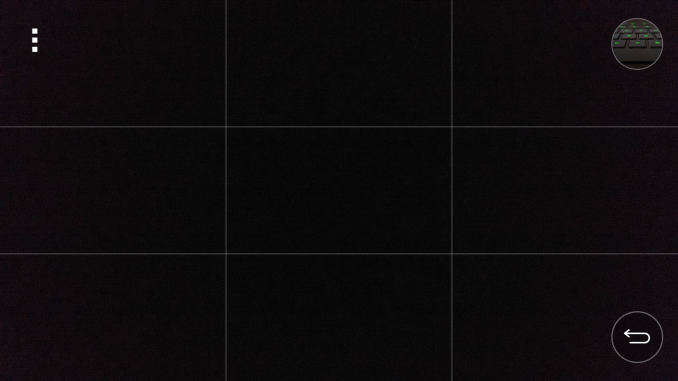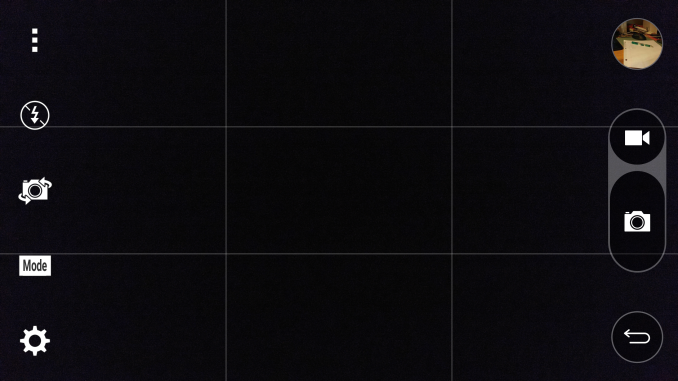The LG G4 Review
by Joshua Ho on July 30, 2015 10:00 AM EST- Posted in
- Smartphones
- Qualcomm
- LG
- Mobile
- Snapdragon 808
- LG G4
Camera Architecture
We can talk about how specs don’t matter in general, but then they definitely matter for cameras. If an OEM chose to make a camera with a 0.5 micron pixel size, it would be obvious that there would be some severe issues with noise and imaging quality. If an OEM decided to ship a camera with an f/5.6 aperture, it would be obvious that low light quality would suffer as a result. If an OEM decided to ship a rear-facing camera with a 1/6” sensor size, it would be obvious that the camera wouldn’t be very good.
I can keep going with these examples, but the point here is that the component choices made here can have a major effect on image quality and the overall user experience of the camera. At the same time though, it’s important to keep in mind that the camera system itself is just one aspect of what makes a great camera. Image processing also plays a huge role in overall camera quality, and for the most part is a black box that we can’t really examine. In the case of the LG G4 it’s especially important to examine the changes to architecture as seen in the table below.
| Camera Architecture | |||||
| LG G3 | LG G4 | ||||
| Front Camera | 2.1MP | 8MP | |||
| Front Camera - Sensor | IMX208 (1.4µm, 1/5.8") |
T4KA3 (1.12µm, 1/4.0") |
|||
| Front Camera - Focal Length | 1.8mm | 2.6mm | |||
| Front Camera - Max Aperture | F/2.0 | F/2.0 | |||
| Rear Camera | 13MP | 16MP | |||
| Rear Camera - Sensor | IMX135 (1.12 µm, 1/3.06") |
IMX234 (1.12 µm, 1/2.6") |
|||
| Rear Camera - Focal Length | 3.97mm (29mm eff) | 4.42mm (29mm eff) | |||
| Rear Camera - Max Aperture | F/2.4 | F/1.8 | |||
If we track the progression of camera upgrades from the LG Optimus G to today, we can see that jump from the OG to G2 saw upgrades to the sensor, OIS, and optics, while the G3 was mostly an upgrade in the form of better OIS and laser AF. The G4 represents a major refresh over the G3 though, with a change to the sensor, optics, and a new white balance sensor that incorporates both IR and visible wavelength measurements.
In the case of the IMX234 sensor, we have very little data regarding improvements to color filtering, sensitivity, full well capacity, or anything else beyond sensor size and resolution. However, if we assume a straight increase in sensor size with no other changes in key sensor spec the sensor will be about 35% more sensitive than the sensor of the G3/G2 although this would be mostly in comparison to the IMX214 rather than the IMX135 of the G3/G2.
When it comes to optics, aperture widens significantly as well from f/2.4 to f/1.8, which would also introduce a 77.8% increase in sensitivity independent of sensor size, although it’s important to keep in mind that chasing aperture for the sake of aperture can significantly compromise practical resolution across the field of view. Equivalent focal length is also slightly shorter at about 28mm while the G3 was closer to 29mm, likely a concession to reduce the z-height of the sensor which allows for a wider field of view at the cost of reduced resolution and increased distortion.
The laser AF sensor continues to be included with this generation, and after some digging that didn't make it into the LG G3 review, I managed to find that the sensor used here is an ST-M VL6810 time of flight sensor which confirms that this is a modified version of a proximity/light sensor and relies on an 850nm laser to accurately determine absolute range out to 10cm, which can be roughly correlated to certain points on the auto-focus mechanism. The OIS mechanism has also improved from 1 degree of compensation to 2 degrees, which is definitely noticeable in practice. Stabilization on the LG G4 has a tendency to feel a bit looser than the stabilization on the GS6, but I suspect this is mostly due to the larger size rather than any real difference.
The final piece here is the color spectrum sensor, which is interesting but another black box like the laser AF sensor. As far as I can tell this is an AMS TCS3490 light sensor which has RGBC + IR sensing capabilities, which allow for light source detection and color temperature measurements. However, in my experience this sensor or the AWB hybrid mechanism has a tendency to select some strange white balances like the Galaxy S6 that have to be corrected by moving the viewfinder around a bit before it fixes itself.
Overall, LG seems to have all the right pieces for a solid camera, but when it comes to camera the devil is really in the details so we can’t quite stop here when it comes to camera analysis. Analyzing how the camera really performs is best done with real-world testing, so that’s where we’ll go next.
Camera UX
While camera quality matters is ultimately what matters in a camera, the user experience of the camera can often determine whether something is possible or not. Issues like slow and/or unreliable auto-focus mechanisms, poor camera controls, poor preview resolution/fps, and long shot to shot time can often make it impossible to capture a good photo even if the camera is more than capable of taking one.
As smartphones, tablets, and other mobile devices have increasingly become the primary way in which people capture and share photos, the user experience associated with the camera and the camera quality itself has become crucial. I don’t think it’s a far leap at this point to say that a significant portion of people may never use anything other than a smartphone as their main camera given the cost and logistical issues involved in carrying a dSLR everywhere.
In order to evaluate the LG G4’s camera user experience, we can break the camera down into two key aspects, namely the camera application and camera latency. Some users may prefer to use third party camera applications, but these are often limited in capability due to limitations of the camera API exposed by the OEM. As a result, key features are often restricted to the first-party camera app.
In the case of the LG G4, we can start by saying that this is easily the best camera application I’ve ever seen on any phone, bar none.
Ever since my first smartphone one of the first things that I wanted to have was full manual control over my camera due to issues with auto focus in macro and other challenging situations. The other issue was I often wanted more control over shutter speed and sensor gain, as it’s often possible that I would find myself in a low light situation where I could stabilize the camera by propping it against some random object but couldn’t force the shutter to expose for enough time to enable acceptable exposure. I also increasingly found that most smartphones on the market have some truly terrible post-processing settings. Noise reduction was often too aggressive on luminance noise (film grain), but too weak on color noise which is far more obvious. I’ll keep my complaints here rather short though as a discussion of post-processing is easily a separate discussion that is much larger than a single phone.
At any rate, the G4’s camera application can be launched with a single double-tap of the volume-down key when the phone is asleep. Unfortunately, LG has also dictated that doing this automatically takes a photo, which is a bit pointless when it’s almost impossible to make the photo properly composed when you do this. Otherwise, the quick launch gesture is well-executed helpful to have.
Once in the camera, you have a choice of three modes mapped to the action overflow button. These modes are simple, auto, and manual. With simple, you have no choice of any particular setting. Tapping anywhere on the screen will cause the camera to expose and focus for the point that you tap and take a photo. One issue I noticed here was that settings in auto mode affected the settings in simple mode, but otherwise this mode works without issue. There’s also no clear way of activating video recording on this mode that I can see.
Auto mode is essentially without flaws in the G4, as you get the ability to set crucial options for auto mode with no pointless extras. Without accessing another menu, you can set capture mode for panoramas and dual shot, switch to the FFC, and adjust flash settings. With a tap of the settings gear, you can set HDR to auto, on, or off, aspect ratio, voice shutter, timer, and a framing grid. Given that this mode is supposed to be good for everyday use, LG has managed to keep this mode clear of clutter while leaving the essentials. I suspect most people will be able to get by with just this mode for almost anything. However, the manual mode is really what sets this phone apart from the rest that I’ve tested in recent memory.
At the start of this section, I said the G4’s camera application is the best that I’ve ever seen on any phone, and if you were to judge it based upon the simple and auto modes you would probably come to a very different conclusion. However, the manual mode really transforms the UI.
In manual mode the auto mode controls are still mostly present, but the HDR toggle is replaced with a histogram toggle, and instead of panorama mode you have access to a RAW toggle. A new row of information is added to the top of the display, with a histogram, white balance setting, focus mode, light meter, sensor gain, and integration time. This helps with knowing what’s actually going on in the photo, even if you set everything to automatic you can still tell if the ISO/exposure isn’t quite right for what you want. For manual controls, you can set manual white balance in steps of 200K, with icons that indicate various points for conditions like fluorescent lights and cloudy skies. There’s also manual focus, exposure compensation, ISO, shutter speed, and exposure lock. All of these settings are implemented correctly, as the UI only shows one control at a time to avoid cluttering up the preview frame with adequate precision for each control (no ridiculously small or large jumps between settings).
The one complaint I have here is that the manual focus mode doesn’t have an option to automatically zoom in when touching the manual focus slider, which makes it a bit slow to get a macro shot in focus due to the need to manually set digital zoom to check if the phone is focused on the right object. Other than this one issue, the camera UI is easily one of the best I’ve ever used. There’s always room for improvement, but in the case of the G4 there’s very little need to improve.
Moving past the camera app itself, latency is a critical aspect of a smartphone camera. Although throughput is important for burst shots, for the most part people want to just take one photo of something rather than a burst of 30-40 to pick through for the right photo. As a result, it's really crucial for smartphones to respond quickly when taking a photo and focus quickly as well. In order to test this in a standardized manner, we look at the best-case focus speed and capture speed by using a well-lit ISO resolution chart. Of course, there's room to improve here in the form of varying contrast, dynamic range, and luminance conditions but this test should give a pretty good idea of what a camera is capable of in the ideal case.


Broadly speaking, focus latency is pretty much at the same level as the LG G3. This isn't too much of a surprise, as the same laser AF system is used and there's no addition of PDAF to do closed-loop AF with when in good lighting conditions. The real improvement here is coming from capture latency, which is a significant improvement over the G3 and manages to slightly edge out the Galaxy S6. However, it should be noted that in low light conditions the shutter can go as long as 1/8 seconds, which will affect capture latency. In addition, HDR mode has a noticeable processing lag which can affect shutter speed in high-contrast conditions. However, in general the G4 is an incredibly quick camera, and in low light laser AF works quite well while PDAF is often unable to improve focus latency.















84 Comments
View All Comments
bleached - Sunday, August 2, 2015 - link
http://www.dxomark.com/Mobiles/Column-right/Mobile...Arcetnathon - Wednesday, August 5, 2015 - link
You point something really strange.Each review of tech website published month after release is worst than first tests.
Maybe big company doesn't play fair and send very specific smartphone that will never be in store...
akdj - Thursday, August 6, 2015 - link
As an owner of three of the top 5; S6, Note 4, & indeed... The iPhone 6+, which raps the 'top 5' "Apples is (sic) 'rate' in the top five'The 6+ is indeed produced by Apple ...my subjective feelings are almost identical to Josh's. S6 Edge is an incredible camera. I love it. My Note 4 always has been, with micro SD it makes shooting 4k practical, but my low light shots are pretty sad in comparison to the 6+, as well as 'action' or fast moving shots. S6 shoots 4k, excellent 1080p, but the video stabilization and 60fps-240fps adjustments on the iPhone tump the other two, and I'm just realizing I've placed my response after the wrong reply of your dxo link.
It's saying damn near what Josh concluded. DxoMark is specific to still photography, heavy on resolution and to those ends the sensors in the S6, N4 & G4 indeed play in the same field as the iPhone ...and in some cases beat it. That said, for simplicity point and shoot and nearly every time get an excellent shot without latency or buffering, the iPhone is hard to beat. Without G4 experience I'll hold judgement, but for video, the iPhone is it. For stills, I'm partial now to my S6 and the Note 4 has always been phenomenal
Apple opening their 'souls' a bit with the ability to interact with the SoC ala their native apps, there are plenty of manual control, high resolution shooters (using the 8 megapixel, 4K sensor and its speed) as well as slow motion and video editing tools --- probably the biggest weight in the iphone's favor is the App Store, it's amazing selection of editing and shooting tools as well as continuous updates might just top the subjective list of top 5.
*i don't own a 4K TV but I've got the ability to playback 4K on my MacBook Pro -- looks amazing but it's limited in length of time you can shoot and heats the camera up nice and warm. The S6, all around, my favorite for everything and now my go to camera in most situations. It's smaller and easier to shoot --- but for video capture, my son playing baseball, or last weeks Mötley Crüe show, the iPhone and it's incredible stabilization, video processing and iCloud uploading, ....see where I'm going?
I own a business, have for two decades and with a dozen employees equipped with their choice, I pay for them ...and have iPhone as a personal - S6 personal and Note4 business only. Primarily the stylus and autographs for credit cards has a cool vibe with clientele. You mileage may vary but dxo mark scores in the mid 80s rivals and defeats many point and shoot cams under $300. A point or two difference isn't real world, nor the bible on what to buy. Iphone is ranked 5 & 6 (+ & standard) - can't seem to find the Experia in America and their separation of a couple points in the mid 80as -- without considering motion at all, I'm not sure ANY is the wrong choice and for many that don't want manual control, the iPhone with HDR is hands down the layman's favorite. Android, I'm with the S6, double tap home button to pop the cam and it's rare even as a DSLR shooter that I'm adjusting settings, modes or manually selecting ISO, Aperture or shutter speed
S6 Edge, I love it. 6+, love it. Note 4, still awesome - bit heavier but easily used now with experience and the right case
Take motion into the equation and the limitations on 4K, post processing there of and playback ...I think this is the reason Apple has put this much effort into their sensor as it's the perfect 'size' for non cropped, full sensor 4K shooting
Maybe I'm confused, but I'm ambidextrous, love both and have owned both since 07/08. Dxomark is a silly geek site for resolution of serious optics. Those scores and their differential is hardly a 'win' for any flagship mentioned
J
Pissedoffyouth - Thursday, July 30, 2015 - link
How does the handoff between clusters cope compared to the 810? Does it scale from 2>4 cores when stepping down, averaging the load across the A53 cluster?nikaldro - Thursday, July 30, 2015 - link
The S808 throttles about as much as the exynos 7420.nikaldro - Thursday, July 30, 2015 - link
The S808 throttles about as much as the exynos 7420.grayson_carr - Thursday, July 30, 2015 - link
My God. I thought this review would never come. I already lusted after the G4, bought the G4, owned the G4 for a while, and then bought a Nexus 6 to replace it haha. Still, it will be good to know the Snapdragon 808 lowdown seeing as the Moto X 2015 and Nexus 5 2015 will make use of it.ThisIsChrisKim - Thursday, July 30, 2015 - link
I bought the G4 and I'm really liking it--camera is just superb. UI is meh, but not annoying enough for me to get something else.Nice seeing this review, nonetheless!
grayson_carr - Thursday, July 30, 2015 - link
I liked the G4 (maybe even more than the Galaxy S6 I owned before it), but there were a couple minor annoyances that ultimately led me to buy a Nexus 6. I found that the G4 performed well most of the time, but as mentioned in the review, in some apps it would drop frames more often than the previous two phones I owned (Nexus 5 and Galaxy S6). Also, the touchscreen seemed to be less responsive than the previous phones I owned, which started to get on my nerves. Finally, there were a couple software annoyances like the inability to expand notifications in some circumstances, that were bothering me. I did like the screen on the G4 better than the Galaxy S6 and Nexus 6, and the manual camera controls were boss, but ultimately I prefer the Nexus software experience.Fitnesspro - Thursday, July 30, 2015 - link
Grayson. You are right. Speed and battery count. I liked the G4 specs but was disappointed when tried the phone out at T Mobile. Has a snag and the actual screen id not